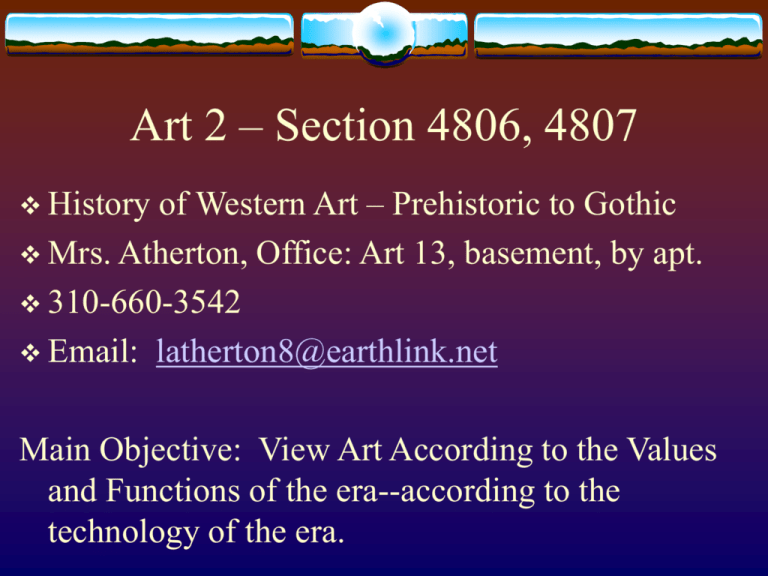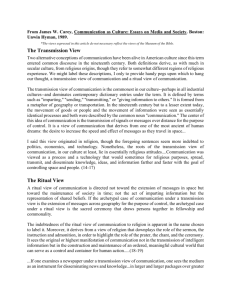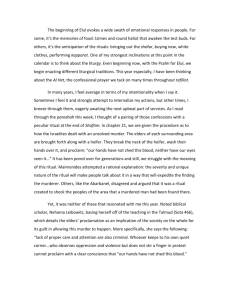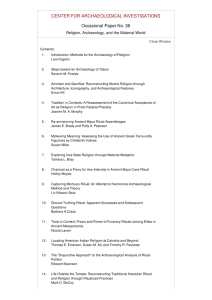Functions of Art - El Camino College
advertisement

Art 2 – Section 4806, 4807 of Western Art – Prehistoric to Gothic Mrs. Atherton, Office: Art 13, basement, by apt. 310-660-3542 Email: latherton8@earthlink.net History Main Objective: View Art According to the Values and Functions of the era--according to the technology of the era. Student Information Please write the following information about yourself, to help me get to know you. Name Semester at El Camino and Major Reason taking the class Telephone and/or email address Whether you would use an optional chat time on Monday, 4 pm or Tues. 8pm Any other Art Hist. or Appreciation classes? List them. Anticipated strengths and Weaknesses in the class Functions of Art Art 2 – Prehistoric To Gothic Functions of Art Expression Ritual / Spiritual transmission of beliefs, knowledge and symbolism Utilitarian – architecture, jewelry, etc. Preservation feels the need to preserve his traditions, folklore, a part of himself Commemoration Universal Themes of Art/ Functions of Art Religious/spiritual - often relies on symbolism, often interwoven with the next factor of communication Communication - power of the visual image to sway one’s thinking, or to enhance the ritual or communication with another life force Communication occurs on several levels: man with himself, with the animals and nature, and with a supreme power or god. Functions of Art (continued) Communication Uses Art to aid in communicating- one self – Expressionism With another person With one’s ancestors With God, or the gods With Nature - Animism As an aid to ritual or devotion With Ritual Bakota tribe, (Gabon) Guardian Figure (left) Bambara Tribe (Mali) Antelope Headdress, (right) Ritual Functions of Art: This wood-carved antelope with the baby on its back was made by the Bambara tribe in Mali. It is used as part of a ritual to promote good crops. The dancer wears this as a headdress since it is attached to a wicker basket at the bottom. The Bambara Antelope Ritual At the left are two dancers participating in the agricultural ceremony of the Bambara. The far left is a representation of the male antelope and on the right is the female with the baby. Bakota Guardian Figure Ritual Carvings such as the one on the left were used in a ritual for burial. The Bakota tribe of the Gabon in Africa create these as guardian figures for the graves of their ancestors. Below the torso, a wicker basket would be attached to hold the bones of the ancestor. Spiritual and Expression - St. Lazare Church, Autun In this Romanesque sculpture carved by Gislebertus, he uses his own individualized manner of representing Eve picking the apple and the first sin. The elongated, reclining Eve are his unique expression. Spiritual The Gothic Cathedrals. A Stain glass window from Chartres Cathedral Spiritual Utilitarian - man feels need to combine art with everyday objects--sometimes for embellishment for pride, for commercial interests, for art for “art’sake”, sometimes to fully absorb his life Commemoration -to commemorate an individual, a country, a country’s triumphs, rarely it’s losses Transmission -feels the need to transmit the knowledge of his latest skills, technology, philosophy, or religious beliefs, etc.--a vast range of information and data, uses art to preserve and celebrate his age. Preservation -feels the need to preserve: his tradition , his folklore, legends, his unique heritage -feels the need to preserve his immortality--to leave a part of himself and his culture on this earth Spiritual /Transmission of Knowledge and Symbolism An Early Christian Sarcophagus (left) and a catacomb painting Ritual /Communication Cave near Pueblo Bonito, New Mex. Chaco Canyon, New Mex. The Supernova Pictograph This pictograph (painting on stone) was made by the Anasazi culture to record an important event which occurred in the year1054, when a supernova star exploded near a crescent moon. Preservation – Egyptian Book of the Dead Many cultures have seen the need to preserve their heritage, rituals, or folklore through their art. They differ from our time in not wishing to record in writing these sacred concepts but pass them on through the art. Preservation – Temple of Zeus, Olympia The myths of Herakles were preserved through Greek art. Here we see him ready to receive the world from Atlas and Athena. Commemoration - Altar of Peace of Augustus, Rome Augustus, the first Emperor, ruled from 27 BC to 14 AD. It was the longest period of peace in Roman history, so he commissioned this Altar to commemorate his reign. Utilitarian/Decorative Egyptian King Tutankamun’s bracelet. It is decorative, but also holds ritual meaning as we see the “Scarab” on top done in lapis lazuli, which insures the King re-birth in the after life. Universal Themes of Art/ Functions of Art Religious/spiritual - often relies on symbolism, often interwoven with the next factor of communication Communication - power of the visual image to sway one’s thinking, or to enhance the ritual or communication with another life force Communication occurs on several levels: man with himself, with the animals and nature, and with a supreme power or god. Utilitarian - man feels need to combine art with everyday objects--sometimes for embellishment for pride, for commercial interests, for art for “art’sake”, sometimes to fully absorb his life Commemoration -to commemorate an individual, a country, a country’s triumphs, rarely it’s losses Transmission -feels the need to transmit the knowledge of his latest skills, technology, philosophy, etc.--a vast range of information and data, uses art to celebrate his age. Preservation -feels the need to preserve: his tradition , his folklore, legends, his unique heritage -feels the need to preserve his immortality--to leave a part of himself and his culture on this earth What do you think is the most important function for art? Answer on the Discussion Board under Prehistoric and Tribal





